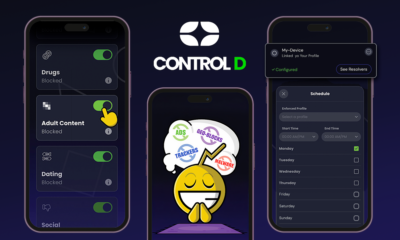TECHNOLOGY
Tech and Data Advancements That Can Further Your Career

Your ability to make progress in your career can depend on a range of factors, including your technical abilities, your personality, and your performance in your previous roles.
It’s important to adopt practices that enable you to improve your working efficacy and demonstrate your value as a contributor or leader in your field. Tech and data advancements can play a key part in this.
This is because the diversity of technological developments emerging continues to offer agile solutions to a variety of business challenges. By establishing which of these can best fit into your strategy for progression, you can mitigate the potential for professional stagnation. Not to mention that many data and tech applications can simply make your day-to-day activities more manageable, allowing you to focus on activities that directly boost your professional journey.
We’re going to explore a few of the tech and data advancements that can further your career.
Virtual Training
No matter what stage of your career you’re in, education is important. This isn’t just from the perspective of leveling up your skill set, though that can certainly be impactful. You’ll also find that industries and practices are changing all the time, particularly as new technology emerges. Your continued efforts to learn can keep you a relevant, valuable, and innovative contributor to any business. However, it can be challenging to fit practical training around work.
This is one area where advances in data and technology are proving impactful. There are a growing number of virtual learning tools that enable you to access professional development wherever you happen to be. This includes e-Learning certification and refresher courses, many of which may incorporate video calls, meaning that you can benefit from meaningful classroom interactions without excessive disruption to your schedule.
In addition, extended reality (XR) learning protocols are improving accessibility to, and the quality of, an increasing number of courses. This involves a combination of virtual reality (VR), augmented reality (AR), and mixed reality (MR) tools. If you work in a hazardous industry, part of your learning can take place in fully virtual environments while providing you with practical experience. The AR and MR elements can then play a role in transitioning your actions to real-world situations.
Remote Productivity Tools
Productivity is an essential component of any role. This is true whether you’re an entry-level worker or an executive decision-maker. Your ability to demonstrate that you consistently make efficient and impactful contributions in your position can be a key to your career advancement. One way you can boost productivity is to operate in an environment that is most suited to your individual needs. If this involves working from home, it’s important to utilize tech and data advancements that bolster your efforts.
This may vary depending on the industry you work in. For instance, there is a growing range of healthcare roles that can be performed remotely. This includes clinical professions — such as physical therapy and nursing — alongside administrative billing and coding positions. Some of the key productivity technology in this industry includes automated transcription software to take notes during telehealth calls and remote patient monitoring devices that minimize the need for in-person visits.
That said, there are certainly some remote productivity tools that can keep you on track no matter what sector you’re in. Agile collaboration platforms that offer video calls, audio notes, and instant messaging can empower you to interact with colleagues in ways that fit your immediate needs. Strong data-driven threat detection cybersecurity tools can also mitigate the potential for breaches that disrupt your productivity in a remote environment.
Artificial Intelligence Platforms
Artificial Intelligence (AI) represents one of the most fascinating tech and data advancements to arise from the growth of the digital landscape. There are certainly risks and concerns surrounding its industry implementation. However, learning how to leverage the positive elements of AI tools can have a positive impact on your career progression.
This can involve adopting AI systems to automate repetitive or data-rich tasks. This could include administrative activities such as data input, analysis, and accounting. There are also platforms to support you in more complex tasks for those in leadership roles. For instance, AI-driven recruitment tools can enable you to source and screen candidates to build the most positive, impactful, and innovative team for your projects. This can help produce results that are effective for achieving your career goals.
However, it’s equally important to know how to be an effective collaborator with AI tech. Focus on gaining solid data literacy skills is essential to effectively interpret information from systems and identify the highest-quality data sets to provide your AI software. It can also be worth taking the time to experiment with AI technology. Test out what it is capable of and how you can interact with it on a professional level. You may uncover innovative practices that boost your efficacy.
Conclusion
Tech and data advancements can improve your working practices and skill sets in ways that can help you achieve your career goals. It can be wise to use virtual learning tools to access courses that level up your value to businesses in your industry. You can also find that remote technology and AI platforms can have productivity and efficiency advantages that highlight you as a key influencer of success.
That said, it’s important to recognize that these technologies are frequently developing in new ways. Taking the time to explore them might unlock unexpected career benefits. Look into how project management tools could improve both your productivity and your work-life balance. Consider how data analytics tools might be useful in assessing industry skills gaps that you could focus on filling.
Regardless of the industry you operate in, remember that a commitment to your ongoing digital literacy is always empowering. After all, it enables you to utilize the most relevant tools in an increasingly tech-reliant business landscape.
TECHNOLOGY
Next-gen chips, Amazon Q, and speedy S3

AWS re:Invent, which has been taking place from November 27 and runs to December 1, has had its usual plethora of announcements: a total of 21 at time of print.
Perhaps not surprisingly, given the huge potential impact of generative AI – ChatGPT officially turns one year old today – a lot of focus has been on the AI side for AWS’ announcements, including a major partnership inked with NVIDIA across infrastructure, software, and services.
Yet there has been plenty more announced at the Las Vegas jamboree besides. Here, CloudTech rounds up the best of the rest:
Next-generation chips
This was the other major AI-focused announcement at re:Invent: the launch of two new chips, AWS Graviton4 and AWS Trainium2, for training and running AI and machine learning (ML) models, among other customer workloads. Graviton4 shapes up against its predecessor with 30% better compute performance, 50% more cores and 75% more memory bandwidth, while Trainium2 delivers up to four times faster training than before and will be able to be deployed in EC2 UltraClusters of up to 100,000 chips.
The EC2 UltraClusters are designed to ‘deliver the highest performance, most energy efficient AI model training infrastructure in the cloud’, as AWS puts it. With it, customers will be able to train large language models in ‘a fraction of the time’, as well as double energy efficiency.
As ever, AWS offers customers who are already utilising these tools. Databricks, Epic and SAP are among the companies cited as using the new AWS-designed chips.
Zero-ETL integrations
AWS announced new Amazon Aurora PostgreSQL, Amazon DynamoDB, and Amazon Relational Database Services (Amazon RDS) for MySQL integrations with Amazon Redshift, AWS’ cloud data warehouse. The zero-ETL integrations – eliminating the need to build ETL (extract, transform, load) data pipelines – make it easier to connect and analyse transactional data across various relational and non-relational databases in Amazon Redshift.
A simple example of how zero-ETL functions can be seen is in a hypothetical company which stores transactional data – time of transaction, items bought, where the transaction occurred – in a relational database, but use another analytics tool to analyse data in a non-relational database. To connect it all up, companies would previously have to construct ETL data pipelines which are a time and money sink.
The latest integrations “build on AWS’s zero-ETL foundation… so customers can quickly and easily connect all of their data, no matter where it lives,” the company said.
Amazon S3 Express One Zone
AWS announced the general availability of Amazon S3 Express One Zone, a new storage class purpose-built for customers’ most frequently-accessed data. Data access speed is up to 10 times faster and request costs up to 50% lower than standard S3. Companies can also opt to collocate their Amazon S3 Express One Zone data in the same availability zone as their compute resources.
Companies and partners who are using Amazon S3 Express One Zone include ChaosSearch, Cloudera, and Pinterest.
Amazon Q
A new product, and an interesting pivot, again with generative AI at its core. Amazon Q was announced as a ‘new type of generative AI-powered assistant’ which can be tailored to a customer’s business. “Customers can get fast, relevant answers to pressing questions, generate content, and take actions – all informed by a customer’s information repositories, code, and enterprise systems,” AWS added. The service also can assist companies building on AWS, as well as companies using AWS applications for business intelligence, contact centres, and supply chain management.
Customers cited as early adopters include Accenture, BMW and Wunderkind.
Want to learn more about cybersecurity and the cloud from industry leaders? Check out Cyber Security & Cloud Expo taking place in Amsterdam, California, and London. Explore other upcoming enterprise technology events and webinars powered by TechForge here.
TECHNOLOGY
HCLTech and Cisco create collaborative hybrid workplaces

Digital comms specialist Cisco and global tech firm HCLTech have teamed up to launch Meeting-Rooms-as-a-Service (MRaaS).
Available on a subscription model, this solution modernises legacy meeting rooms and enables users to join meetings from any meeting solution provider using Webex devices.
The MRaaS solution helps enterprises simplify the design, implementation and maintenance of integrated meeting rooms, enabling seamless collaboration for their globally distributed hybrid workforces.
Rakshit Ghura, senior VP and Global head of digital workplace services, HCLTech, said: “MRaaS combines our consulting and managed services expertise with Cisco’s proficiency in Webex devices to change the way employees conceptualise, organise and interact in a collaborative environment for a modern hybrid work model.
“The common vision of our partnership is to elevate the collaboration experience at work and drive productivity through modern meeting rooms.”
Alexandra Zagury, VP of partner managed and as-a-Service Sales at Cisco, said: “Our partnership with HCLTech helps our clients transform their offices through cost-effective managed services that support the ongoing evolution of workspaces.
“As we reimagine the modern office, we are making it easier to support collaboration and productivity among workers, whether they are in the office or elsewhere.”
Cisco’s Webex collaboration devices harness the power of artificial intelligence to offer intuitive, seamless collaboration experiences, enabling meeting rooms with smart features such as meeting zones, intelligent people framing, optimised attendee audio and background noise removal, among others.
Want to learn more about cybersecurity and the cloud from industry leaders? Check out Cyber Security & Cloud Expo taking place in Amsterdam, California, and London. Explore other upcoming enterprise technology events and webinars powered by TechForge here.
TECHNOLOGY
Canonical releases low-touch private cloud MicroCloud

Canonical has announced the general availability of MicroCloud, a low-touch, open source cloud solution. MicroCloud is part of Canonical’s growing cloud infrastructure portfolio.
It is purpose-built for scalable clusters and edge deployments for all types of enterprises. It is designed with simplicity, security and automation in mind, minimising the time and effort to both deploy and maintain it. Conveniently, enterprise support for MicroCloud is offered as part of Canonical’s Ubuntu Pro subscription, with several support tiers available, and priced per node.
MicroClouds are optimised for repeatable and reliable remote deployments. A single command initiates the orchestration and clustering of various components with minimal involvement by the user, resulting in a fully functional cloud within minutes. This simplified deployment process significantly reduces the barrier to entry, putting a production-grade cloud at everyone’s fingertips.
Juan Manuel Ventura, head of architectures & technologies at Spindox, said: “Cloud computing is not only about technology, it’s the beating heart of any modern industrial transformation, driving agility and innovation. Our mission is to provide our customers with the most effective ways to innovate and bring value; having a complexity-free cloud infrastructure is one important piece of that puzzle. With MicroCloud, the focus shifts away from struggling with cloud operations to solving real business challenges” says
In addition to seamless deployment, MicroCloud prioritises security and ease of maintenance. All MicroCloud components are built with strict confinement for increased security, with over-the-air transactional updates that preserve data and roll back on errors automatically. Upgrades to newer versions are handled automatically and without downtime, with the mechanisms to hold or schedule them as needed.
With this approach, MicroCloud caters to both on-premise clouds but also edge deployments at remote locations, allowing organisations to use the same infrastructure primitives and services wherever they are needed. It is suitable for business-in-branch office locations or industrial use inside a factory, as well as distributed locations where the focus is on replicability and unattended operations.
Cedric Gegout, VP of product at Canonical, said: “As data becomes more distributed, the infrastructure has to follow. Cloud computing is now distributed, spanning across data centres, far and near edge computing appliances. MicroCloud is our answer to that.
“By packaging known infrastructure primitives in a portable and unattended way, we are delivering a simpler, more prescriptive cloud experience that makes zero-ops a reality for many Industries.“
MicroCloud’s lightweight architecture makes it usable on both commodity and high-end hardware, with several ways to further reduce its footprint depending on your workload needs. In addition to the standard Ubuntu Server or Desktop, MicroClouds can be run on Ubuntu Core – a lightweight OS optimised for the edge. With Ubuntu Core, MicroClouds are a perfect solution for far-edge locations with limited computing capabilities. Users can choose to run their workloads using Kubernetes or via system containers. System containers based on LXD behave similarly to traditional VMs but consume fewer resources while providing bare-metal performance.
Coupled with Canonical’s Ubuntu Pro + Support subscription, MicroCloud users can benefit from an enterprise-grade open source cloud solution that is fully supported and with better economics. An Ubuntu Pro subscription offers security maintenance for the broadest collection of open-source software available from a single vendor today. It covers over 30k packages with a consistent security maintenance commitment, and additional features such as kernel livepatch, systems management at scale, certified compliance and hardening profiles enabling easy adoption for enterprises. With per-node pricing and no hidden fees, customers can rest assured that their environment is secure and supported without the expensive price tag typically associated with cloud solutions.
Want to learn more about cybersecurity and the cloud from industry leaders? Check out Cyber Security & Cloud Expo taking place in Amsterdam, California, and London. Explore other upcoming enterprise technology events and webinars powered by TechForge here.
-

 SEO7 days ago
SEO7 days agobrightonSEO Live Blog
-

 WORDPRESS6 days ago
WORDPRESS6 days ago9 Best WooCommerce Multi Vendor Plugins (Compared)
-

 SEO5 days ago
SEO5 days agoGoogle March 2024 Core Update Officially Completed A Week Ago
-

 MARKETING5 days ago
MARKETING5 days agoNavigating the Video Marketing Maze: Short-Form vs. Long-Form
-
SEARCHENGINES7 days ago
Daily Search Forum Recap: April 25, 2024
-

 SEO6 days ago
SEO6 days agoGoogle Declares It The “Gemini Era” As Revenue Grows 15%
-
![The Current State of Google’s Search Generative Experience [What It Means for SEO in 2024] person typing on laptop with](https://articles.entireweb.com/wp-content/uploads/2024/04/The-Current-State-of-Googles-Search-Generative-Experience-What-It.webp-400x240.webp)
![The Current State of Google’s Search Generative Experience [What It Means for SEO in 2024] person typing on laptop with](https://articles.entireweb.com/wp-content/uploads/2024/04/The-Current-State-of-Googles-Search-Generative-Experience-What-It.webp-80x80.webp) MARKETING5 days ago
MARKETING5 days agoThe Current State of Google’s Search Generative Experience [What It Means for SEO in 2024]
-

 SEARCHENGINES5 days ago
SEARCHENGINES5 days agoGoogle March 2024 Core Update Finished April 19, 2024














